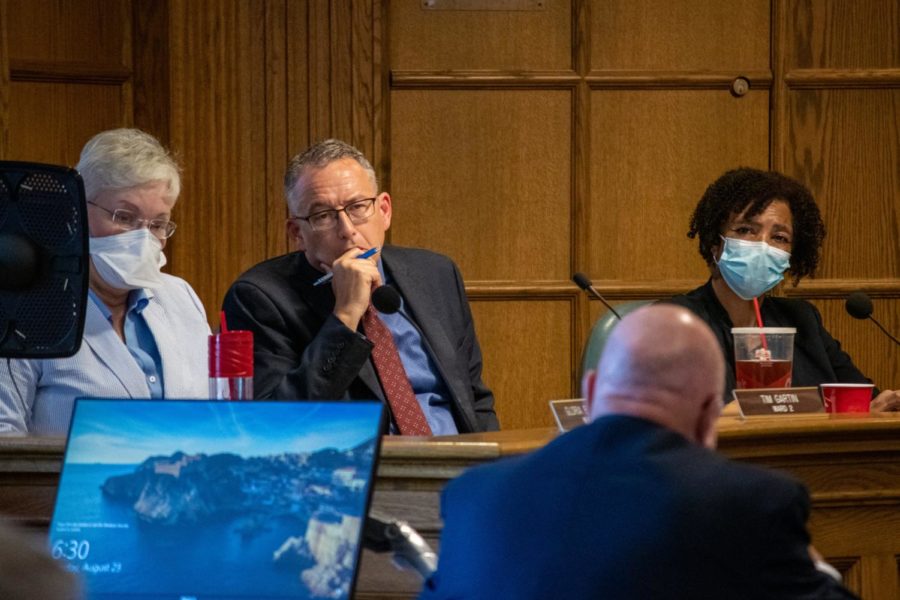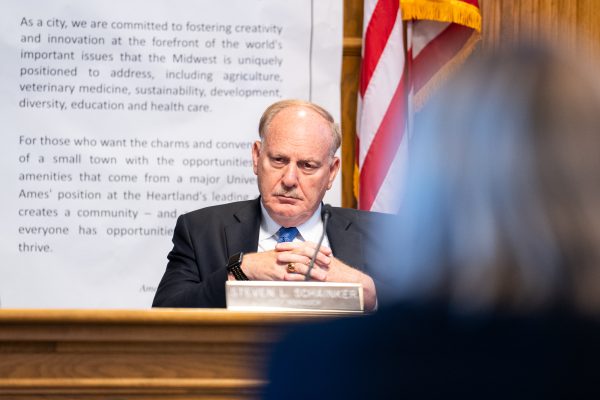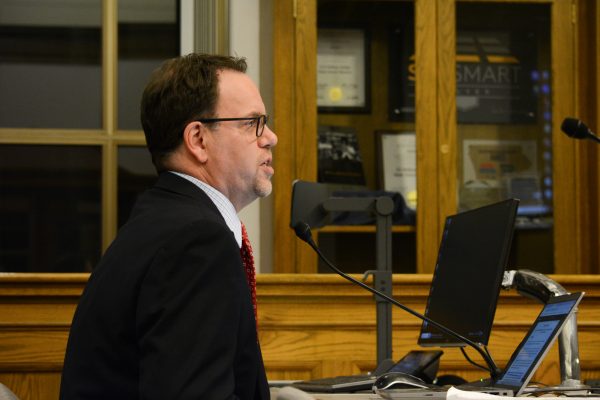City Council set to address Climate Action Plan staff report
The Ames City Council’s Climate Action Plan is a framework and action plan that outlines the guiding principles and resulting action plan needed to reduce greenhouse gas emissions in Ames, according to the city’s website.
The Ames City Council is set to address the city staff report on the Climate Action Plan Tuesday.
The Climate Action Plan is a framework that outlines the guiding principles and resulting action plan needed to reduce greenhouse gas emissions in Ames, according to the city’s website. In total, the plan is projected to cost a total of $2.3 billion, offsetting 24.2 tons of carbon.
According to city documents, the staff report includes the cost of and gain on investment, the amount of administrative effort needed, the feasibility of achievement, legal feasibility, funding sources, impact on residents (such as property taxes and utility rates), impact on inclusion and the cost compared to the tonnage of carbon reduced.
In December of 2021, the council voted to reduce carbon emissions in Ames by 80% by 2030, with the goal of reaching net-zero in 2050. To achieve their goals, the Climate Action Plan lists six big moves the city can take, the first of which is to install retrofits to needed structures around the city.
Retrofits
The report states that by 2030, all 17 municipal buildings should be retrofitted and that 30% of energy should be saved through process efficiency. By 2035, 90% residential, commercial, industrial and institutional buildings should be retrofitted.
The report continues to state that by 2040, 26,691 air-source heat pumps should be installed in all buildings, and 19,338 hot water heating systems should be replaced with electoral systems.
The report states that an increase in property taxes and utility rates would have a significant impact on residents. Should residents switch to electrical water heating systems, their natural gas bills would decrease.
Net-zero new construction
The report defines net-zero new construction as “creating ultra-efficient residential,
commercial, and municipal buildings by utilizing integrated design and building
techniques that generate on-site energy, using clean renewable energy resources
in a quantity equal to or greater than the needs of the buildings.”
Net-zero construction also requires renewable energy to be able to be produced on new construction, although they will not be installed at the time of construction, according to the report. As a result, net-zero building would bring a reduction in energy costs to the building owner as well as a reduction in greenhouse gas emissions.
The action steps to be taken by the city require that all buildings constructed in 2026 and thereon after be net-zero ready, with a linear increase toward the goal beginning by 2023. The city is also suggested by staff to set a passive house standard by 2030, which would set an energy usage limit based on the square footage of the building.
“Currently there is a lack of expertise in the community for implementing this type of
Standard,” the report states in regard to the steps’ feasibility. “The steps to adopt a standard would be relatively easy but ensuring there is a contracting community available with expertise to meet the standards is unknown.”
The plan currently does not list any plans for additional funding, stating that future costs will likely be included in current fees.
The report states that no single-family homes could be constructed at a price point that would categorize them as affordable or low-income housing.
“Reduced monthly energy bills would be beneficial, but it is unknown if rent or mortgage payments would be higher and offset the saving on energy bills,” the report states.
Renewable energy generation
The report states that adding additional sources of renewable energy to the city as well as investing in individual and community sources of renewable energy such as wind and solar could significantly decrease emissions from the community, homes, businesses and electric vehicles.
The big moves’ action steps include:
–Maxing out rooftop solar potential
–Adding a 50 MW solar farm by 2525, an addition 50 MW farm by 2030 and another 200 MW farm between 2035 and 2045
–Adding a 20 MW wind farm by 2026
–Adding Tesla power walls or other forms of home scale battery storage to every home when an electric vehicle is acquired
The action steps also include moving local energy production to electric by 2023 and renewable gas by 2030, but the report states that the technology is currently not readily available and that the action step is to be determined at a later date.
Reducing vehicle emissions
In regard to reducing vehicle emissions, the report requires all light and medium-duty vehicles sold in 2030 and on must be zero-emission vehicles, with heavy-duty vehicles being required to be electric. The action steps continue to state that between 2023 and 2030, the city must increase the proportion of biodiesel use by 5% each year.
The report states that the feasibility of the plan hinges on the supply of all-electric vehicles, which have a higher demand than production.
“For example, it appears larger vehicles like trucks, fire trucks, etc. needed for our work might not be available for a number of years,” the report states.
The report states that this big move would result in an increase in property taxes and utility rates, which would adversely affect low-income households.
Increasing active transportation and transit use
According to the report, active transportation refers to more sustainable modes of transport including walking, cycling, carpooling and public transit.
The action steps for this big move include a reduction in vehicle miles traveled throughout the city, the implementation of car and bike share programs, having 10% of the trips completed in the city by 2050 done by transit, replacing 17 buses by 2027 with electric buses and replacing buses that are the end of their lifecycle, and having 40% of the trips under 1.5 miles completed by walking and 3 miles by bike by 2025.
The report states that the move toward increasing active transportation would pose a significant impact on property tax rates but could offer significant benefits in regard to inclusion which may offset the increase.
Reducing waste emissions
The action steps regarding reducing waste emissions include:
–Decreasing the waste per household at the source by 20% by 2030 and by 50% by 2050
–Diverting 50% of commercial waste at the source by 2030
–Diverting 90% of organic and food waste by 2028
–Ensuring the recycling of 90% of glass, metal, paper, cardboard and other paper products by 2028
-Establishing a new waste-to-energy system
The report states that this big move would bring an increase of roughly 6% in tipping fees in regard to decreasing commercial and household waste decrease and diversion, with an additional 6% to offset the 50% reduction in waste volume. There would also be an approximate 14% increase in tipping fees to cover the costs associated with organic and food waste diversion and an approximate 7.5% increase in tipping fees to address costs and fees associated with the city’s projected increase in recycling. The report adds that the fee increases would place a burden on low-income families.
The report describes the goal of diverting 90% of organic and food waste by 2028 as “extremely aggressive.”
“To achieve this action step, organics diversion would depend on the acceptance by the residential and commercial community to change their handling of organic waste and the level of incentives that the City is willing to provide,” the report states.
Your donation will support the student journalists of the Iowa State Daily. Your contribution will allow us to purchase equipment, send our student journalists to conferences and off-set their cost of living so they can continue to do best-in-the-nation work at the Iowa State Daily.












Rj Traver | Nov 14, 2022 at 9:28 am
I guess only professors will be able to afford to live in Ames.